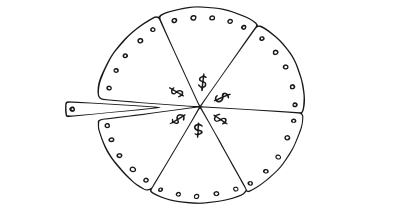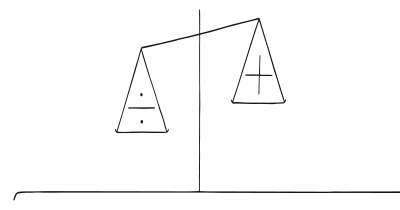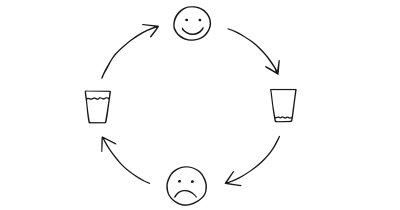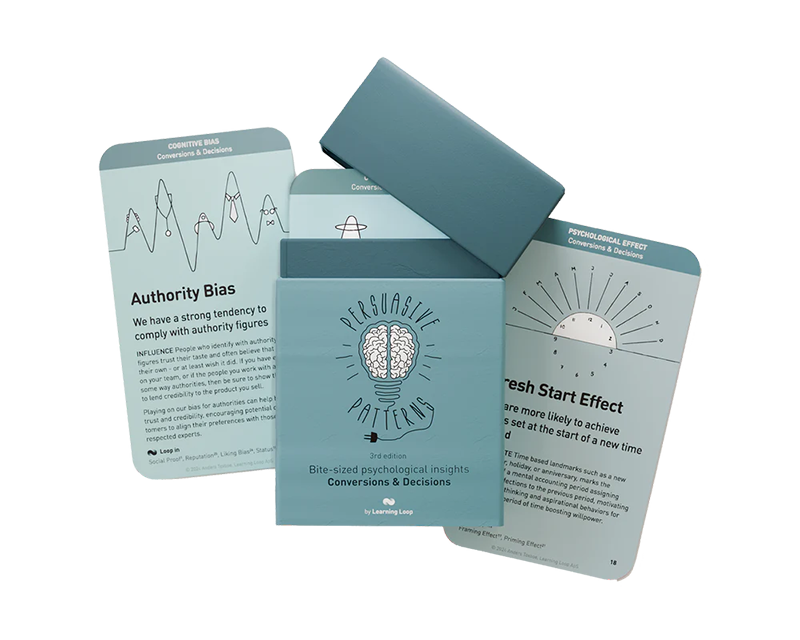Persuasive Patterns: Facilitation
Present Bias
What we want now is not what we aspire to in the future

Present bias describes our tendency to prioritize immediate rewards over future benefits, even when the future benefits are objectively greater.
Present bias isn’t just about impulsive purchases; it’s a deeply ingrained human tendency. Consider someone trying to get in shape. They know the long-term benefits of exercise – improved health, weight loss, increased energy. However, present bias can make that evening jog seem less appealing than relaxing on the couch. The immediate reward of comfort outweighs the future benefit of exercise.
Many digital apps leverage present bias to nudge users towards desired behaviors. Imagine someone trying to learn a new language. A language learning app might overwhelm them with a massive curriculum. Instead, it can leverage present bias by offering short, engaging lessons with immediate feedback and points for completion. These small, immediate rewards make language learning feel less daunting and more appealing in the moment, motivating users to keep coming back for more.
The Marshmallow Test
One of the most influential studies on present bias is the “Marshmallow Test,” initially conducted by psychologist Walter Mischel in the late 1960s. The study explored the ability of children to delay gratification and how it predicted their future success. Children were offered a choice between one small reward provided immediately or two small rewards if they waited for a period of approximately 15 minutes, during which the experimenter left the room and then returned. The follow-up studies tracked the participants into adulthood, showing that those who waited longer tended to have better life outcomes, measured by various indicators such as academic success, health, and general well-being.
Mischel, W., Shoda, Y., & Rodriguez, M. L. (1989). Delay of gratification in children. Science, 244(4907), 933-938.
Present bias is a fundamental human cognitive bias that significantly influences our decision-making. We often place a higher value on instant gratification than on long-term gains. This can lead to choices that contradict our long-term planning and rational decision-making, as people disproportionately value immediate pleasures or conveniences despite potential long-term consequences. Understanding and addressing present bias is crucial for designing interventions that encourage better choices in health, finance, education, and environmental sustainability.
This seemingly irrational behavior is rooted in a fundamental psychological principle called temporal discounting. Temporal discounting simply means that the value we assign to a reward diminishes the further in the future it lies.
Several psychological factors contribute to the allure of the immediate. One factor is temporal impatience. We naturally gravitate towards satisfying our needs and desires right away. The delayed gratification of waiting for a reward, no matter how substantial, often feels less appealing than the satisfaction of having something now. Imagine a child offered a marshmallow today or two marshmallows if they wait a few minutes. The immediate reward (one marshmallow) holds greater value due to temporal impatience.
Another factor is the availability heuristic. We judge the likelihood of events based on how easily we can imagine them. Future rewards often feel abstract and uncertain, while immediate rewards feel more concrete and attainable. This mental shortcut can lead us to undervalue future benefits. For instance, saving for retirement might feel less tangible than the enjoyment of a new gadget we can buy today.
Finally, present bias is influenced by the self-control cost. Making choices that prioritize long-term benefits often requires exerting self-control in the present. Resisting temptation can be draining, making us more likely to opt for the immediate gratification that requires less self-control. This explains why unhealthy snacks might seem more appealing than healthy options that require resisting temptation in favor of long-term health benefits.
Temporal discounting provides a deeper understanding of present bias. It posits a non-linear relationship between the value of a reward and the delay in receiving it. Rewards are valued more highly the sooner we receive them, with the discount rate becoming steeper as the wait time increases. This explains why a smaller reward today can be more tempting than a much larger reward received later.
Hyperbolic discounting, a refinement of temporal discounting, suggests that the discount rate is highest for very short delays and then decreases over time (Ainslie, 1975). This explains why the immediate gratification of a small reward can outweigh the promise of a much larger reward even a short time later.
Furthermore, the dual-systems theory suggests that present bias might be attributed to the dominance of System 1, the emotional and impulsive system, over System 2, the rational and deliberative system. In the face of immediate temptation, our emotions and impulses often overpower our ability to make calculated decisions based on long-term goals.
Present bias ties into concepts of self-control and willpower, which are necessary to resist short-term temptations in favor of long-term benefits. The struggle between immediate desires and future well-being reflects an internal conflict of self-regulation. Understanding this internal battle is crucial for mitigating the effects of present bias.
Additionally, some psychological models suggest that individuals differ in their reward sensitivity. Those with higher reward sensitivity are more likely to exhibit present bias, as they feel the pull of immediate gratification more acutely.
By recognizing the psychological underpinnings of present bias, we can develop strategies to counter its influence. For instance, making future benefits more salient or restructuring our environment to reduce immediate temptations can help us align our actions with our long-term goals. Additionally, educating ourselves about present bias and employing self-regulation techniques can empower us to make decisions that are more consistent with our future aspirations.
Designing products knowledge of the Present Bias
By understanding how we prioritize the “now,” designers can craft experiences that nudge users towards desired actions. Here’s how to leverage present bias in a way that benefits both users and your product:
Integrate immediate rewards into the user experience that also align with long-term benefits. A fitness app that provides instant feedback on calories burned after a workout satisfies the desire for immediate results while promoting long-term health. This approach harnesses present bias by making progress feel rewarding from the start, ultimately supporting long-term goals.
Make the abstract tangible. Financial services often face the challenge of encouraging saving for the future when immediate spending is tempting. Design saving platforms that offer visual progress indicators, such as filling progress bars or growing trees. These visuals transform the act of saving from a future-oriented chore into a present-oriented reward, making the abstract concept of saving more tangible and immediately gratifying.
Complex tasks can be daunting, and present bias can lead to procrastination. Break down these tasks into smaller, more manageable actions with clear rewards for each step. Educational tools and complex software can benefit from this approach. By rewarding immediate, simple achievements that accumulate toward comprehensive learning or project completion, each step feels valuable, keeping users engaged and motivated.
In e-commerce, leverage present bias by creating urgency with time-limited offers or flash sales. The immediate opportunity to save money or obtain a limited product can motivate quick decision-making. However, balance this urgency with clear communication about the long-term benefits of the product. This ensures long-term user satisfaction and loyalty, not just purchases driven by a fleeting deal.
Help users to lock-in on long-term goals
Another take to design around the Present Bias is by employing “future lock-in” strategies that help move users beyond their initial impulsive decision and set them on a path towards sustained success. This not only benefits users by helping them achieve their desired outcomes, but also translates to long-term product engagement and a more sustainable user base for your product.
Facilitate “future lock-in” by separating the decision-making process from the point of gratification. Encourage users to pre-commit to long-term goals by requiring them to make choices in advance. For instance, grocery delivery services that require scheduling deliveries a few days in advance can help users avoid impulse purchases when faced with immediate temptations.
Ethical recommendations
Present bias is a powerful psychological principle that, if misused, can lead to ethical dilemmas and potential harm to users. The crux of present bias lies in its ability to exploit the human tendency to overvalue immediate rewards at the expense of long-term benefits.
This can lead companies to design products or services that encourage impulsive decisions, such as excessive spending, overconsumption of digital media, or neglect of health and wellness. For example, offering too many short-term incentives for purchasing products can lead consumers into debt or cause them to acquire items they do not need and might regret buying later. Similarly, digital platforms that capitalize on present bias by continuously providing instantly gratifying content may contribute to screen addiction, reducing the overall well-being of users.
To ensure that the use of present bias in product design and marketing is both ethical and user-centric, consider the following best practices:
- Be transparent
Be clear and open about how your products use mechanisms that exploit present bias. Inform users about the potential long-term consequences of their choices, helping them make informed decisions. Be upfront about the value proposition and potential consequences of using your product. Avoid manipulative tactics and ensure users understand the rationale behind design choices. - Balance immediate and long-term value
While it is acceptable to use present bias to enhance user engagement, it is crucial to balance this with the promotion of long-term benefits. Ensure that your products deliver sustained value that supports the users’ long-term goals and well-being. Clearly communicate how present actions contribute to lasting benefits. - Support informed decision-making
Empower users to make informed decisions. Provide clear information, avoid manipulative dark patterns, and allow users to opt-out of features that exploit present bias. Instead of solely focusing on the short-term advantages, provide educational content that helps users understand the importance of their decisions in a broader temporal context. This could involve comparison tools, long-term projections, and educational resources that highlight the benefits of delayed gratification. - Facilitate user control and customization
Provide users with the ability to control or customize their interactions with your product to mitigate potential negative effects of present bias. For example, allow users to set limits on usage or spending within apps.
Real life Present Bias examples
Weight Watchers
Weight Watchers integrates present bias by providing immediate feedback through its point system. Users log food to receive instant feedback on their choices, making it easier to stick with the program by seeing immediate results in their daily point totals, which ties into longer-term weight loss goals.
Robinhood
The trading app Robinhood caters to present bias by providing instant access to trading without waiting for traditional brokerage processing. This immediate action capability appeals to users’ desires to engage in trading quickly, aligning with the broader financial growth aspirations.
Amazon Prime
Amazon effectively uses present bias by offering Prime members immediate benefits like same-day or one-day shipping. This instant gratification supports the decision to subscribe and retain the service, despite the annual fee, by continuously appealing to the desire for immediate reward.
Trigger Questions
- Can we break down complex tasks into smaller, immediately rewarding steps?
- How can we visually represent progress towards long-term goals?
- Are we clearly communicating the lasting benefits alongside immediate rewards?
- Can we leverage limited-time offers or scarcity to create a sense of urgency without sacrificing long-term value?
- Do our designs empower users to make informed decisions aligned with their future selves?
- How can we measure the impact of present bias strategies on user behavior and long-term engagement?
Pairings
Present Bias + Social Proof
Social proof leverages the power of conformity. Imagine a fitness app that highlights the number of users currently engaged in a workout alongside immediate calorie burn feedback. This combines the allure of immediate results (present bias) with the social influence of “everyone’s doing it” (social proof), motivating users to join the active community.

What we want now is not what we aspire to in the future

We assume the actions of others in new or unfamiliar situations
Present Bias + Commitment & Consistency
We tend to follow through on commitments we’ve made. A language learning app might leverage present bias by offering points for daily practice sessions (immediate reward), while simultaneously employing a streak counter that highlights user commitment and consistency (commitment & consistency). This creates a positive reinforcement loop that encourages continued learning.

What we want now is not what we aspire to in the future

We want to appear consistent with our stated beliefs and prior actions
Present Bias + Loss Aversion
Present bias and loss aversion can work together by emphasizing immediate losses that might result from inaction. For example, in financial services, highlighting the immediate negative impact of not saving or the potential fees one might incur can motivate users to take action to avoid these losses.

What we want now is not what we aspire to in the future

Our fear of losing motivates us more than the prospect of gaining
Present Bias + Scarcity Bias
Pairing present bias with scarcity can create a powerful motivator. When products or opportunities are presented as limited-time offers, the urgency to act immediately due to present bias is intensified by the fear of missing out, which scarcity evokes.

What we want now is not what we aspire to in the future

We value something more when it is in short supply
Present Bias + Rewards + Feedback Loops
Integrating present bias with a rewards system that provides immediate feedback can reinforce desired behaviors quickly. This is evident in gaming and learning platforms where immediate rewards (points, badges) are used to encourage continued engagement and progression.

What we want now is not what we aspire to in the future

Use rewards to encourage continuation of wanted behavior

We are influenced by information that provides clarity on our actions
Present Bias + Framing Effect
Using the framing effect, one can present information in a way that highlights immediate benefits, which appeals to present bias. For instance, marketing a product by emphasizing what users can gain right now helps capture their interest more effectively than projecting future benefits alone.

What we want now is not what we aspire to in the future

The way a fact is presented greatly alters our judgment and decisions
Present Bias + Goal-Gradient Effect
This effect suggests our motivation intensifies as we near a goal. A language learning app could leverage present bias by awarding points for completed lessons (immediate reward) while visually depicting progress towards daily or weekly goals (goal-gradient effect). Seeing progress visually close in creates a sense of urgency and motivates users to complete remaining tasks to achieve their language learning goals.

What we want now is not what we aspire to in the future

Our motivation increases as we move closer to a goal
Present Bias + Sunk Cost Bias
Although typically viewed negatively, in some contexts, the tendency to continue an endeavor once an investment has been made can be used positively. Encouraging users to invest time, effort, or even money into their goals can make them more likely to stick to these goals to justify their initial investment.

What we want now is not what we aspire to in the future

We are hesitant to pull out of something we have put effort into
A brainstorming tool packed with tactics from psychology that will help you increase conversions and drive decisions. presented in a manner easily referenced and used as a brainstorming tool.
Get your deck!- Ice cream soon and vegetables later by Milkman, Rogers & Bazerman
- How Soon Is Now? Evidence of Present Bias [ by Balakrishnan, Haushofer & Jakiela
- Present Bias
- Present bias at Wikipedia (en)
- Mischel, W., Shoda, Y., & Rodriguez, M. L. (1989). Delay of gratification in children. Science, 244(4907), 933-938.
- Ainslie, G. (1975). Specious reward: A behavioral theory of impulsiveness and impulse control. Psychological Bulletin, 82(4), 463-496.
- Loewenstein, G., & Prelec, D. (1992). Anomalies in intertemporal choice: Evidence and an interpretation. Quarterly Journal of Economics, 107(2), 573-597.
- Laibson, D. (1997). Golden eggs and hyperbolic discounting. Quarterly Journal of Economics, 112(2), 443-478.
- Frederick, S., Loewenstein, G., & O'Donoghue, T. (2002). Time discounting and the preference for immediate rewards: A critical review. Journal of Economic Literature, 40(2), 351-401.
- Xu, J., Luo, Y., & Shen, L. (2014). The effects of gamification on user experience and learning outcomes: A literature review. International Journal of Playing, 3(3), 115-124.
- Thaler, R., & Shefrin, H. M. (1981). "An economic theory of self-control." Journal of Political Economy, 89(2), 392-406.
- Thaler, R. H. (1999). Mental accounting matters. Journal of Behavioral Decision Making, 12(3), 183-206.
- Lyubomirsky, S., & Layous, K. (2013). "How do simple positive activities increase well-being?" Current Directions in Psychological Science, 22(1), 57-62.
- Baumeister, R. F., & Heatherton, T. F. (1996). Self-regulation failure: An overview. Psychological Inquiry, 7(1), 1-15.
- Seligman, M. E. P., Railton, P., Baumeister, R. F., & Sripada, C. (2013). Navigating into the future or driven by the past. Perspectives on Psychological Science, 8(2), 119-141.
